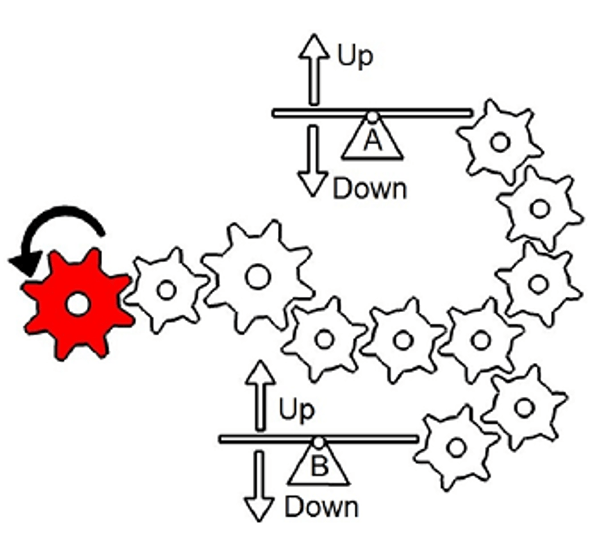 Free Elevator Industry Aptitude Test Practice Questions [2025]
Free Elevator Industry Aptitude Test Practice Questions [2025]
The EIAT Test, also known as the Elevator Union test or the Elevator Industry Aptitude test, is an initial screening stage for becoming an elevator mechanic and joining the elevator industry.
Here you'll find an EIAT test prep with free Elevator Industry questions and answers, including detailed explanations, and insider test tips for acing the test.
For full preparation, see the JobTestPrep PrepPack.
Also, see our free PDF guide.
The test consists of three sections:
- Verbal Reasoning – 25 minutes
- Mechanical Reasoning – 25 minutes
- Numerical Reasoning – 40 minutes
Key Details:
- Calculator: Not allowed
- Administration: Paper-based test
- Pass score: 70%

To get a better sense of what our practice tests look like, take this interactive assessment.
Free Elevator Industry Aptitude Practice Questions
The elevator assessment includes 3 sections – Numerical Reasoning (Math), Mechanical Aptitude, and Verbal Reasoning.
The EIAT test is followed by an additional Tool Recognition test. Let's start with some math sample questions.
Numerical Reasoning (Math) Sample Questions
The EIAT math section has 25-35 questions on Basic math, Fractions, and Decimals.
You will not be allowed to use a calculator, meaning your math skills will need to be on point.
1. Elevator Industry Aptitude Test Practice Sample Question #1 (Basic Math).
5732 x 0.001 = ?
A. 573.2
B. 57.32
C. 5.732
D. 0.5732
E. 0.05732
Answer:
A quick and simple trick to follow - the decimal point moves an equal amount of places on each side of the product in the opposite direction:
5732 x 0.001 =
= 573.2 x 0.01
= 57.32 x 0.1
= 5.732 x 1
= 5.732 - The answer is C.
2. Elevator Industry Aptitude Test Practice Sample Question #2 (Basic Math)
142 x 37 = ?
A. 3,742
B. 5,180
C. 5,254
D. 2,744
E. 4,211
Answer:
A straightforward calculation is going to take quite a lot of time here. So, let's use shortcut methods instead.
2 x 7 = 14 → The last digit is 4.
Therefore, the answer should be either C (5,244) or D (2,744).
Now, let’s combine this method with the “first digit method”.
In our case:
1(00) x 3(0) = 3(000) = 3,000
Since 142 x 37 > 100 x 30, the result should be larger than 3,000 → C (5,254)
3. Elevator Industry Aptitude Test Practice Sample Question #3 (Fractions and Decimals)
0.55 - 2/10 = ?
A. 3/10
B. 7/20
C. 35/55
D. 53/100
E. 2/5
Answer:
0.55 - 2/10 = 55/100 - 20/100
= 35/100
Simplify by dividing 35/100 by 5
= 7/20 - The answer is B.
4. Elevator Industry Aptitude Test Practice Sample Question #4 (Fractions and Decimals)
13/4 x 26/7 = ?
A. 2.87
B. 3.25
C. 3.28
D. 4.5
E. 5
Answer:
This is a classic question for the estimation method.
13/4 x 26/7 ~ 1.75 x 3 = 5.25
Since 26/7 < 3, the final result will be a little less than 5.25, namely 5.
This final result may surprise you at first glance, but you may calculate this and see it for yourself.
To fully master such methods, you must be practiced and experienced with them.
Numerical Reasoning Tip
Under time pressure, as illustrated in question 1, it's advisable to use shortcuts when working without a calculator.
For instance, when handling decimals and fractions, it's simpler to convert them to whole numbers for easier calculations.
Afterward, return the decimal point to its original position to obtain the correct answer.
For more information, check out our free Numerical Reasoning Practice Guide.
The EIAT Test Practice Pack is full of calculation tips and solving shortcuts specifically designed to address the challenges of the numerical reasoning section of the test and elevate the numerical abilities you will need as an elevator mechanic.
With more than 70 Numerical Reasoning Questions, You are sure to improve your skills and be on your way to passing the test.
See What People Say About Our Prep Pack
Click the following page if you're looking for a comprehensive guide to kick-start your career and become an elevator mechanic.
EIAT Tools Practice Questions
The EIAT has a separate tool assessment that's not part of the main EIAT score. This tool assessment will be given immediately after the aptitude test.
It contains questions about the names and uses of tools like diagonal cutters, tape measures, and lineman's pliers, as well as topics on meter reading.
Your performance on this tool assessment will influence your interview score.
Auto and Shop
A "Phillips" and a "flathead" refer to types of what tool?
A. Wrenches
B. Pliers
C. Screwdrivers
D. Hammers
Answer:
These are types of screwdriver heads. Phillips has a cross shape, while flathead is a straight line.

The correct answer is C.
Which of the items below is used for determining whether an item is horizontal?
A. 2
B. 4
C. 1
D. 5
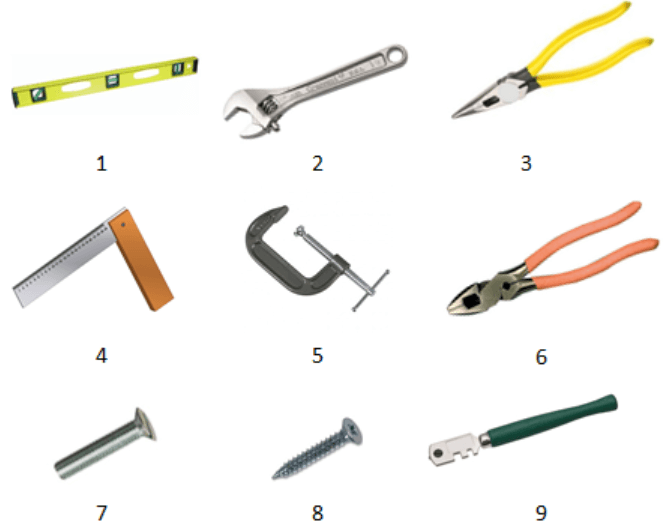
Answer:
The object presented in image 1 is a level. A level is a device designed to indicate whether an object is horizontal or vertical. It consists of a vial filled with a liquid that leaves an air bubble;
the vial slightly curves upwards so that the bubble naturally rests in the middle, the highest point. When the device is slightly inclined, the bubble shifts to the side and away from the marked center.
The tool presented in image 4 is a square, which measures whether an object has a right angle but Isn't able to test whether it is leveled.
The tool presented in image 5 is a C-clamp, which is used for holding objects in place.
The object presented in image 2 is a wrench, which is used for tightening and loosening bolts.
The level is the only device that incorporates a gravity-dependent feature: the air bubble, which changes its position in the tube according to the highest point.
The correct answer is (C).
For more information, check out our free EIAT Tools Practice Guide.
Follow a Proven Path to EIAT Confidence – Get Started Today
No more guessing. Our structured prep system walks you through:
Step 1: A diagnostic test that shows exactly what to focus on
Step 2: Smart practice by topic—mechanical, verbal, and numerical
Step 3: Full-length simulations (75 questions each) to lock in your skills under pressure
Bonus 🎁: Get 6 extra tools practice tests + NEIEP personality prep
Feel ready, not rushed— master the EIAT at your own pace.
Mechanical Aptitude Practice Questions
The Mechanical Aptitude section features between 25 and 35 questions to be answered in roughly 30 minutes. Let's explore a few sample questions.
Mechanical Aptitude- Force and Torque
Which cyclist has to pedal harder in order to go up the ramp?

A. a
B. b
C. The same
Answer:
In this question, we are asked which rider would need to pedal harder in order to climb the ramp.
We can see that though the ramps are of different lengths, the height of the logs in both cases is the same.
For this reason, we should understand that the shorter ramp will be steeper. As is known from daily life, it is harder to pedal up a steeper incline.
Since in Figure B, the length is shorter and the incline is greater, it would be harder to pedal up the ramp. Therefore, choice B is the correct answer.
Answer:
In order to determine in which direction the swings tilt, we will need to determine the rotation direction of each gear that comes in contact with the swing. They are marked in the picture below as gears A and B.
Counting the gears from the red gear to gear A, we see there are 8 gears. Therefore, the red gear and gear A rotate in the same direction – counterclockwise.
That rotation will cause the right arm of swing A to tilt downwards (blue arrow), and therefore the opposite side will tilt upwards.
In the same manner, there are 7 gears between the red gear and gear B, and therefore it will rotate in the opposite direction – clockwise.
That will tilt the right arm of the swing upwards, causing the left side to tilt downwards. Therefore, the correct answer is A.
Mechanical Aptitude - Wheels and Pulleys
Which tractor has to drive farther in order to bring the boat to shore?
A. 1
B. 2
C. The same
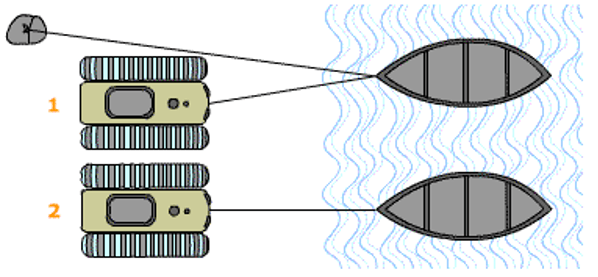
Answer:
Tractor 2 will drive in a straight horizontal heading, in the same direction as the boat is from the shore. This is the shortest line possible.
Tractor 1 will also drive in a horizontal line, but as it is tied to the boat diagonally it will therefore pull the boat over a larger distance.
However, tractor 1 will have to apply less force due to the mechanical help from the rock (the same as in a movable pulley).
Mechanical Aptitude - Cogwheels
Which way will the bottom cogwheel rotate?
A. a
B. b
C. c
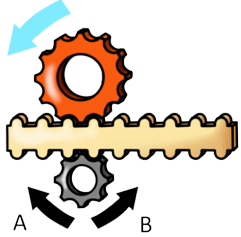
Answer:
When contact is made between the rack (toothed belt) and the cogwheels, a conversion from a linear velocity to an angular velocity occurs. The location of the point of contact is critical.
The point of contact between the red cogwheel and the rack is in the lower part of the red cogwheel. The counterclockwise angular velocity induces a linear velocity to the right.
The point of contact between the grey cogwheel and the rack is in the grey cogwheel's upper part. The linear velocity to the right (determined by the rack) induces an angular velocity in a clockwise direction. The process can be exemplified by the blue arrows, which show where each part of the wheel is moving under the rotation conditions:
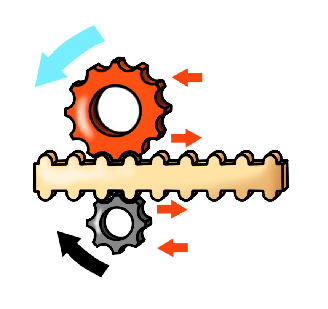
Remember the physical principle: When converting the linear velocity of a rack to the angular velocity, “translate” the rotation into arrows and follow the directions.
The correct answer is A.
Mechanical Aptitude Tip
When answering mechanical reasoning questions in the Elevator Aptitude Test, focus on mechanical principles rather than relying on intuition.
The wording can often be tricky, so it’s important to think through the question methodically.
For example, in question #6, you might feel that riding a bike 15 feet is harder than 12 feet. However, the key concept here is understanding the slope, not the distance itself.
For more tips and practice, check out our free EIAT Mechanical Reasoning guide.
The JobTestPrep EIAT PrepPack includes practice tests that simulate the actual EIAT test rules and intentions and can help you avoid these pitfalls.
For more mechanical questions, check out our IBEW Test Prep and practice your skills!
Verbal Reasoning Sample Questions
The Elevator Aptitude Test Verbal Reasoning section has 25-35 questions on vocabulary, sentence completion, and reading comprehension.
Sentence Completion
"Since each person is ___________, collaborating as a team can bring __________ results."
A. talent … better
B. unique … superior
C. identical … inferior
D. different … continuous
Answer:
Since every person is unique (special), collaborating (working together) as a team can bring superior (better) results.
The first pair of words is not a good match because "talent" is a noun while the sentence calls for an adjective describing the person.
The third pair is incorrect because all people are not identical.
The fourth pair is incorrect because the adjective "continuous" does not make sense in the context of the sentence.
The last pair is incorrect because the word "diversity" is a noun and not an adjective.
Therefore, the correct answer is B - unique ... superior.
Sentence Completion
"The boy was filled with _______ when he saw that his sister broke his favorite toy."
A. Wrath
B. Joy
C. Confusion
D. Doubt
E. Ambition
Answer:
The correct answer is A - wrath, which means anger.
According to the sentence, the boy’s sister broke his favorite toy. We can therefore assume that the boy was filled with a negative emotion. Wrath is a negative emotion, and it fits the context of the sentence.
In case we do not know the word wrath, we can eliminate joy and ambition, which are both positive words.
Confusion is not necessarily a negative emotion, and does not fit the sentence as much as wrath. Doubt means uncertainty, which is can also be marked as incorrect.
Grammar & Spelling
"Touch ID is ____ quite an elegant solution to an ever more ____ problem."
A. actually, singnificant
B. actully, signifikant
C. achtually, sigmificant
D. actually, significant
E. None of these
Answer:
The correct answer is D. Touch ID is actually quite an elegant solution to an ever more significant problem.
Incorrect Answers:
B and C can be eliminated because of the misspelling of 'actually'.
A has 'significant' misspelled.
Sentence Completion
"____ say this is causing ____ damage to the population".
A. experts, profound
B. Experts, profound
C. Expert, profaund
D. Excerpts, profount
E. None of these
Answer:
Experts say this is causing profound damage to the population.
Verbal Reasoning Tip
In the verbal reasoning section, if you're unsure about the correct answer for a sentence completion question, it's helpful to use the process of elimination.
Take question 9 as an example: Answer A 'talent… better' can be ruled out due to grammatical errors, while answer C 'Identical… Inferior' can be dismissed because it doesn't make logical sense.
The bottom line, begin by assessing the grammar of each option and then determine if its logic aligns with the question.
For more information, check out our free EIAT Verbal Reasoning practice guide.
You can find more tips and strategies to solve verbal reasoning questions in the JobTestPrep EIAT preparation.
The verbal section includes a total of 5 practice tests and 90 detailed questions, answers, and explanations.
See What People Say About Our Prep Pack
How to Pass the Elevatory Industry Aptitude Test?
How to Become an Elevator Installer?
To become an elevator installer, you generally must complete a four-year apprenticeship that blends classroom education with practical on-the-job training.
These apprenticeships are commonly offered through unions, industry groups, or individual contractors.

See the following guide for more information on how to become an elevator apprentice.
FAQs
How long is the EIAT test? The test lasts 90 minutes, with:
- Reading: 25 minutes
- Mechanical: 25 minutes
- Math: 40 minutes
If you fail, you won't move to the interview stage and will be removed from the applicant pool. You can re-apply in the next recruitment period.
A passing score is 70%. You must score at least this to continue. Applicants are ranked into four tiers, which are valid for two years
Results arrive after the test, along with your rank. A higher rank can help speed up your apprenticeship process.
Major companies, such as OTIS, Schindler, Thyssenkrupp, and WMATA, use the EIAT when hiring for the elevator industry.
If you pass with a 70% or higher, you'll be scheduled for an interview. Some may also need to take a tools test.
The interview lasts 15-20 minutes and covers education, experience, motivation, safety, and work behavior.

